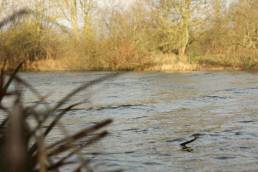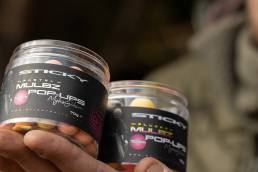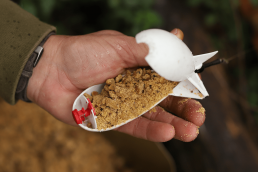
ADAM PENNING TALKS US THROUGH HIS SPECIAL HOMEMADE HOOKBAIT RECIPE, THAT HAS ACCOUNTED FOR STACKS OF HUGE UK CARP OVER THE YEARS
ADAM PENNING TALKS US THROUGH HIS SPECIAL HOMEMADE HOOKBAIT RECIPE, THAT HAS ACCOUNTED FOR STACKS OF HUGE UK CARP OVER THE YEARS
Making your own hookbaits can be a real edge when you’re fishing pressured waters, especially when you’re looking to gain an advantage over other anglers. In this little step-by-step piece, I’m going to go through how I like to make my own baits with a few little additions and tweaks in readiness for the spring ahead.
Bait making is a bit of a dying art these days, and to be honest it’s no surprise when you look at the quality that’s already available. I for one find myself rolling very few due to time constraints but when I can, there’s good reason for it, starting with the inclusion of some of the finest additives on the market.

The Pure Naturals Range has a few little gems which you’ll notice make an appearance in my mix. Packed full of attraction and nutritional benefits to the carp, they’re an incredible addition and will no doubt help you bank more carp this year! Take GLM for instance, potentially one of the greatest additions to any fishmeal bait on the market and a proven winner over countless years of angling since its introduction. Why would you not want to use it if you had the opportunity?
There’s a multitude of benefits to making your own hookbaits, not just for the added attraction but for the buoyancy element too. If you’re only planning on leaving them out for a short period then this wouldn’t necessarily apply, but for those looking to leave a rig in play for potentially 36 hours or more, the last thing you want to be thinking about is whether your pop-up is still just that, a pop-up!

To eliminate this potential danger, you have to use cork balls inside the paste when rolling. It would be very easy to suggest using a ready-made tub of paste, however this could lead to you being back at square one! When rolling a cork ball pop-up, you only use a thin layer of paste, therefore you have to use something that is going to withstand the harsh environment you cast it into. Thankfully, Sticky have this covered with their range of Hookbait Kits, which include hardening agents within them to help bind the finished paste around the cork ball and keep it there!
Once you have mixed up the perfect paste, the amount you place around the cork ball, and the size of the ball itself are important. You want at least a 1mm skin around the whole cork ball, to ensure it stays intact when attaching to your rig. It is a bit of trial and error, and you can get really technical with it, by weighing the exact amount of paste you need, and even transferring them to a rolling table to acquire the perfect shape.
For pop-up hookbaits, 13 or 14mm corkballs make perfect 15 to 16mm hookbaits, but you can take it a step further. By using a 10mm cork ball, with enough paste to make a 16mm finished bait, your finished bait should be a slow sinking, wafter! Meaning you can make two different hookbait variations from one batch of paste; just be mindful to not mix them up in the drying process!

For the easiest process, making your baits at home is best, if the other half can stand the smell, take over the kitchen. If not, then maybe the shed might be your best bet! Occasionally, you may have the time to do them on the bank, which for me makes it all the more rewarding. There’s nothing quite like catching a carp on a bait you made yourself!

ADAM PENNING’S HOMEMADE HOOKBAITSSTEP-BY-STEP
ADAM PENNING’S HOMEMADE HOOKBAITSSTEP-BY-STEP




STEP 1
You will need some eggs, The Krill Hookbait Kit and any additional bits you wish to include.
STEP 2
Start off by cracking three eggs into a mixing bowl.
STEP 3
Then add the full contents of the liquid provided with the hookbait kit.
STEP 4
Add a good helping of L-Zero-30-T, there is no limit to the inclusion of this liquid.




STEP 5
Mix thoroughly until you achieve a running consistency.
STEP 6
Add over half of the hookbait kit to a plastic bag.
STEP 7
Then add two heaped teaspoons of Liver Powder.
STEP 8
Add the same amount of GLM Extract to the bag.




STEP 9
Give the bag a good mix around to distribute the powders evenly.
STEP 10
Begin to add the mixture a little bit at a time until you reach a dough consistency.
STEP 11
It should be easy to mould around a cork ball and not be too sticky.
STEP 12
Larger cork balls can be used for pop-ups and the smaller ones for wafters.




STEP 13
Roll around in the palm of your hand to make a nice evenly rolled ball.
STEP 14
Add to a pan of boiling water for a minimum of 30 seconds to 2 minutes depending on how tough you want them.
STEP 15
Once boiled, leave them on a kitchen towel or even a sack to dry out for a few hours.
STEP 16
Once dry, adding a final touch of The Krill Bait Spray rounds them off perfectly.

STEP 1
You will need some eggs, The Krill Hookbait Kit and any additional bits you wish to include.

STEP 2
Start off by cracking three eggs into a mixing bowl.

STEP 3
Then add the full contents of the liquid provided with the hookbait kit.

STEP 4
Add a good helping of L-Zero-30-T, there is no limit to the inclusion of this liquid.

STEP 5
Mix thoroughly until you achieve a running consistency.

STEP 6
Add over half of the hookbait kit to a plastic bag.

STEP 7
Then add two heaped teaspoons of Liver Powder.

STEP 8
Add the same amount of GLM Extract to the bag.

STEP 9
Give the bag a good mix around to distribute the powders evenly.

STEP 10
Begin to add the mixture a little bit at a time until you reach a dough consistency.

STEP 11
It should be easy to mould around a cork ball and not be too sticky.

STEP 12
Larger cork balls can be used for pop-ups and the smaller ones for wafters.

STEP 13
Roll around in the palm of your hand to make a nice evenly rolled ball.

STEP 14
Add to a pan of boiling water for a minimum of 30 seconds to 2 minutes depending on how tough you want them.

STEP 15
Once boiled, leave them on a kitchen towel or even a sack to dry out for a few hours.

STEP 16
Once dry, adding a final touch of The Krill Bait Spray rounds them off perfectly.









